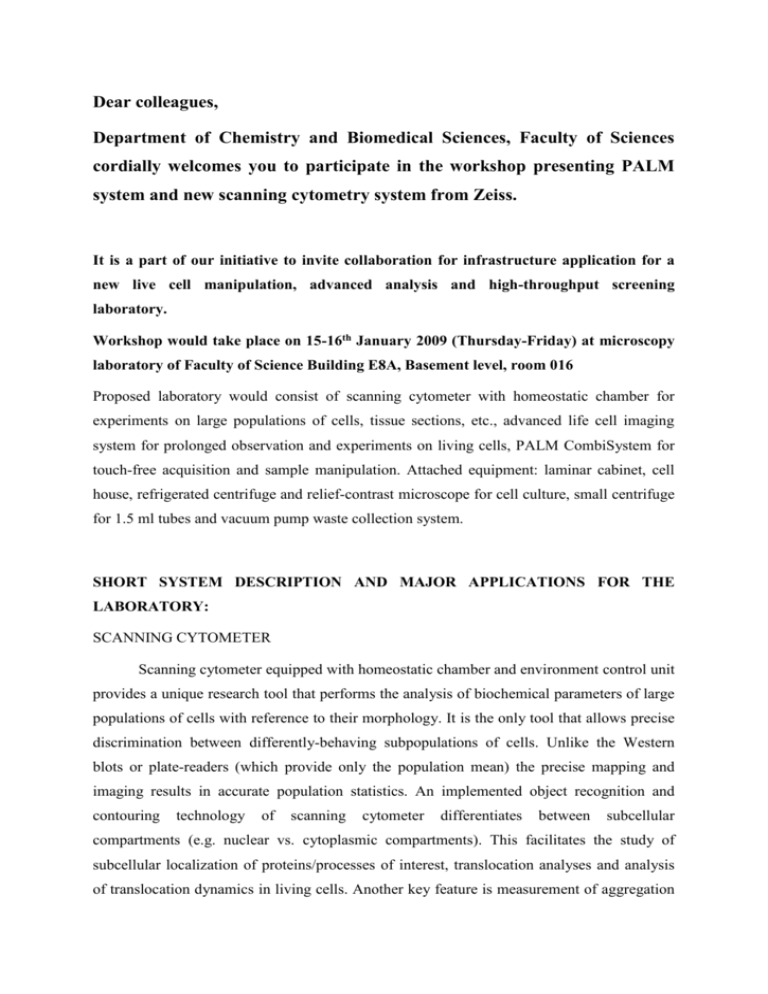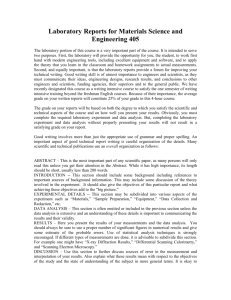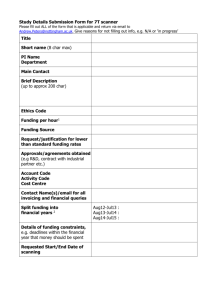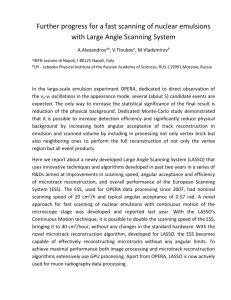1. Workshop Invitation - Fluorescence Applications in Biotechnology
advertisement

Dear colleagues, Department of Chemistry and Biomedical Sciences, Faculty of Sciences cordially welcomes you to participate in the workshop presenting PALM system and new scanning cytometry system from Zeiss. It is a part of our initiative to invite collaboration for infrastructure application for a new live cell manipulation, advanced analysis and high-throughput screening laboratory. Workshop would take place on 15-16th January 2009 (Thursday-Friday) at microscopy laboratory of Faculty of Science Building E8A, Basement level, room 016 Proposed laboratory would consist of scanning cytometer with homeostatic chamber for experiments on large populations of cells, tissue sections, etc., advanced life cell imaging system for prolonged observation and experiments on living cells, PALM CombiSystem for touch-free acquisition and sample manipulation. Attached equipment: laminar cabinet, cell house, refrigerated centrifuge and relief-contrast microscope for cell culture, small centrifuge for 1.5 ml tubes and vacuum pump waste collection system. SHORT SYSTEM DESCRIPTION AND MAJOR APPLICATIONS FOR THE LABORATORY: SCANNING CYTOMETER Scanning cytometer equipped with homeostatic chamber and environment control unit provides a unique research tool that performs the analysis of biochemical parameters of large populations of cells with reference to their morphology. It is the only tool that allows precise discrimination between differently-behaving subpopulations of cells. Unlike the Western blots or plate-readers (which provide only the population mean) the precise mapping and imaging results in accurate population statistics. An implemented object recognition and contouring technology of scanning cytometer differentiates between subcellular compartments (e.g. nuclear vs. cytoplasmic compartments). This facilitates the study of subcellular localization of proteins/processes of interest, translocation analyses and analysis of translocation dynamics in living cells. Another key feature is measurement of aggregation of the studied compounds within the cell. Aggregation parameter describes functionality of compounds (protein activation/inactivation, clustering, chromatin condensation, etc.). Scanning cytometry analysis is performed directly on microscope slides, coverslip chambers and a variety of petri dishes and multi-well plates equipped with coverslip inserts. This property allows the analysis of cell cultures without the need of their detachment from the surface on which they normally grow, a phenomenon that often results in significant change in cell biochemistry and morphology. Scanning of the tissue sections (even the whole small animal cross-sections) and creation of the biochemical/functional map of the analysed tissue, a parameter crucial for physiological and pathological studies, is also possible. Combination of these features together with the capability of high-throughput analysis enables holistic studies of living cells covering both qualitative and quantitative aspects. Examples of applications of scanning cytometry: Live-cycle and viability studies based on DNA content and various biochemical markers (apoptosis, autophagy, mitosis) Quantitative high-throughput analysis of expression, subcellular trafficking and translocation patterns of various proteins in within both fixed and living cells transfected/transformed with fluorescent proteins or labelled with antibodyconjugated fluorochromes/luminescent nanoparticles Quantitative analysis of protein interactions and mapping of interaction-sites in combination with BRET or BiFC techniques Quantitative analysis of organelle transformation/redistribution within the cells High-throughput screening of newly-developed anticancer compounds coupled with morphological analysis and population statistics allowing capture of highly sensitive/resistant cell groups High-throughput analysis of newly-developed anticancer strategies based on combination of anticancer drugs or augmentation of natural anti-tumour mechanisms Quantitative population analysis of the mechanism of cancer cells resistivity to therapies and agents Various aspects of quantitative high-throughput stem-cell analysis, from determination of subpopulations of multi-potent cells in tissue sections to analysis of their biochemical status and differentiation patterns Protein expression mapping and cell population/subpopulation analysis in tissue sections in physiological studies (development, remodelling and involution studies) Protein expression mapping and cell population/subpopulation analysis in tissue sections for pathology/patophysiology (tumour mapping and biochemical characterisation in model animals, as well as in surgically-removed tumours, analysis of prognostic markers prior to, during anti-cancer treatment and follow-up, analysis of cellular and biochemical patterns during tissue recovery after injury or inflammation) FISH studies performed on both cell cultures and tissue sections with precise localisation mapping Automated colony counting together with quick statistical analysis of each colony population and diversity based on fluorescent markers Quick and thorough scanning for regions of interest for correlative microscopy on samples mounted on electron microscopy finder-grids, that provides additional statistical data on protein expression and subcellular distribution ADVANCED LIFE CELL IMAGING SYSTEM This system, if possible will be implemented on the same microscope as the scanning cytometer. It is a highly advanced module for qualitative and semi-quantitative analysis of living cells with high optical resolution. It will allow extensive analysis to be performed on single cells or small populations of living cells over long periods of time. Example applications: Analysis of subcellular trafficking of various compounds and ions Analysis of expression and interactions between studied proteins Analysis of patterns of reorganization of cytoskeleton during cell cycle, cell death, secretion and interactions with pathogens PALM COMBISYSTEM PALM CombiSystem consists of two systems for optical dissection and manipulation. It permits a touch-free approach to sensitive samples that minimises the risk of external contamination to valuable samples. Optical dissection module produces narrowly-focused pulses of high-energy laser beam to thermally ablate elements within sample. This allows precise cutting edge for microsurgery and sample acquisition. Together with optical tweezers they allow extensive manipulation on subcellular scale, precise delivery of nanocapsules, and measurements of binding-forces that govern the microcosmos of a living cell. Example applications for PALM CombiSystem: Acquisition of rare cell populations from tissue cross-sections or primary tissue cultures e.g. stem cells Acquisition of samples from cell cultures and tissue cross-sections for RNA/protein expression analysis Acquisition of transfected/transformed cells Microsurgery and micromanipulation on living cells Measurement of forces of interaction between cells, cells and their surroundings, cells with their parasites and symbionts Analysis of forces of interaction between selected proteins or glucans attached to microbeads in cell-free models Alternative way of manipulation of genetic material in cloning and in-vitro fertilisation Bring your own samples to try! Contact and further information: Mick Godlewski: ext. 8270; mickgodl@hotmail.com Debra Birch: ext. 8131; dbirch@rna.bio.mq.edu.au .








